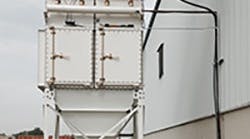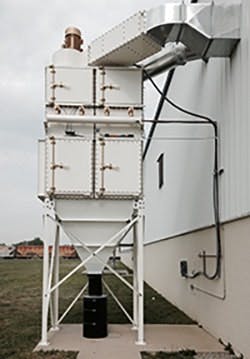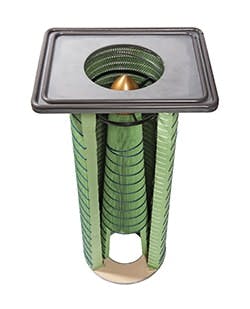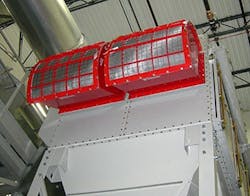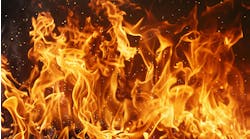Controlling toxic and combustible dust is a common yet serious challenge in chemical processing. Everyday operations like mixing, drying, conveying and blending create dangerous dusts that can become airborne, endanger air quality and pose fire and explosion hazards.
Each facility has unique dust issues based on the materials handled and operations involved. Every chemical processor, though, must comply with U.S. Occupational Safety & Health Administration (OSHA) regulations to protect its employees from exposure to airborne dusts as well as National Fire Protection Association (NFPA) standards to provide a safe working environment.
OSHA Regulations
A company must control toxic chemical dust emissions in the indoor workplace atmosphere to comply with OSHA’s established permissible exposure limit (PEL) for workers. If no legal limits apply, then the firm must define in writing, implement and measure its own environmental safety plan to comply with OSHA’s general duty clause (which mandates a workplace environment free of recognized hazards).
OSHA 1910 — Occupational Safety and Health Standards is a broad, general standard that covers most industries. It’s a comprehensive and complex standard with 20 subsections. OSHA PELs include limits on airborne concentrations of hazardous chemicals in the air for general industry in 1910.1000 — Air Contaminants. They are listed by chemical name in Tables Z-1, Z-2 and Z-3. Most OSHA PELs are 8-hr time-weighted averages, although there also are ceiling and short-term exposure limits. Many chemicals include a designation to warn against skin contact.
Figure 1. Positioning the collector in a location removed from the work area often makes sense.
OSHA 1910.22 — Walking-Working Surfaces is a housekeeping standard that requires all places of employment, passageways, storerooms, service rooms and walking-working surfaces to be clean, orderly, dry, sanitary and free from hazards. This means that a manufacturer must prevent dust from accumulating on these surfaces.
OSHA 1910.134 — Personal Protective Equipment (PPE) covers requirements to minimize occupational diseases caused by breathing air contaminated with harmful dusts, fumes, mists, gases, smokes, sprays or vapors and coming into physical contact with these dusts. It recommends accepted engineering control measures to mitigate these risks as a first step before relying on PPE.
Reducing Worker Exposure
One of the best options for keeping hazardous dusts away from personnel is a dust collection system with high-efficiency primary and secondary cartridge-style filters. It’s preferable to capture chemical fumes and dust at their source — by incorporating a hood or extraction arm into the process machinery — to prevent them from expanding throughout the plant. Source capture is extremely effective and requires the least energy and capital investment.
You should isolate the captured dust from the rest of the facility and contain it in a specific area (ideally one kept under negative pressure). Send the extracted air either directly into a local collector or, via ducts, to a collector located remotely (Figure 1). In some cases with proper HEPA filtration, you can safely return the filtered air back into the facility to create a push/pull airflow pattern to improve contaminant control.
A chemical manufacturing facility also may require special options or accessories to improve the safety and reliability of the system. A site can use bag-in/bag-out filters and contained hopper discharge options to limit exposure and cross-contamination of collected material when performing filter and dust removal maintenance.
Types Of Filters And Filtration Media
Select primary filter media for each application based on the dust particle size, flow characteristics, quantity and distribution. If the dust is toxic and the primary filtration system doesn’t use a HEPA filter, install a secondary HEPA filter downstream. Secondary filters prevent hazardous dusts from discharging to the atmosphere; they can forestall contamination of return air ducting and the associated costs of cleaning hazardous dust leakage.
A wide, uniformly pleated filter allows the collected dust to release from the filter, keeping the resistance lower through the filter for a longer time. When the pleats of the filter media are tightly packed, the dust collector’s reverse pulse cleaning system won’t eject the dust that has settled between the pleats. Tightly packed pleats raise the resistance of the air through the filters and diminish airflow, thus shortening filter life and increasing energy usage.
The choice of pleated media usually depends on dust type, operating temperatures and the level of moisture in the process. Pleated cartridge filters generally rely on one of two basic categories of media:
• Nonwoven cellulosic blend media is the most economical choice for dry dust collection applications at operating temperatures up to 160°F (71°C).
• Synthetic polyester media or polyester/silicon blend is a lightweight media that can handle dry applications with maximum operating temperatures ranging from 180°F (82°C) up to 265°F (129°C). These filters are washable and can recover from a moisture incursion — but aren’t intended for wet applications.
For applications considered a fire risk, opt for standard and nanotechnology filter media treated with a flame retardant. Use conductive or anti-static filters where conveyed dusts generate static charges that require dissipation.
Combustible dusts demand special care because they can cause a fire or explosion if ignited. Dust collectors minimize the amount of combustible dust that can collect on floors and other surfaces, and contain the dust in one area. However, the dust collectors themselves can pose a fire or explosion hazard if they aren’t designed correctly or equipped with the proper explosion or fire protection controls. Cartridge filters with anti-static media also suit explosive dust applications, enabling conformance to NFPA requirements and lessening the risk of ignition sources due to static electricity charges.
Figure 2. Top layer of nanofibers improves dust release during cleaning and lowers pressure drop.
High-efficiency dust collection systems also use self-cleaning mechanisms that regularly pulse dust off the filters, allowing units to run longer between filter change-outs. Applying a layer of nanofibers on top of the base filter media promotes surface loading of fine dust and prevents the dust from penetrating deeply into the filter’s base media. This translates into better dust release during cleaning cycles and lower pressure drop readings through the life of the filter.
Applicable Regulations
In the United States, combustible dust issues fall under the scope of three key entities, each with its own particular area of responsibility:
• NFPA, Quincy, Mass., sets safety standards regarding combustible dust, and amends and updates them on a regular basis. NPFA’s standards aim to prevent an explosion, vent it safely and ensure it won’t travel back inside a building. Most insurance agencies and local fire codes mandate following NFPA standards. Sometimes, though, the authority having jurisdiction (AHJ) specifies an alternative, perhaps even more stringent, safety approach.
• OSHA, Washington, D.C., together with local authorities, enforces NFPA standards. OSHA’s Combustible Dust National Emphasis Program (NEP) outlines policies and procedures for inspecting workplaces that create or handle combustible dusts. OSHA began rulemaking in October 2009 for a general industry standard for combustible dust but has yet to issue a proposed rule.
• U.S. Chemical Safety and Hazard Investigation Board (CSB), Washington, D.C., is an independent federal agency responsible for investigating industrial chemical accidents. The CSB probes into combustible dust explosions, sifting through evidence to determine root causes and then publishes findings and recommendations.
Relevant NFPA Standards
A good starting point for sorting through the standards is NFPA 652 — Standard on the Fundamentals of Combustible Dust. This standard applies to all facilities and operations that deal with combustible dust.
NFPA 654 — Standard for the Prevention of Fire and Dust Explosions from the Manufacturing, Processing and Handling of Combustible Particulate Solids is an all-encompassing standard on how to design a safe dust collection system.
NFPA 68 — Standard on Explosion Protection by Deflagration Venting focuses on explosion venting on devices and systems that vent combustion gases and pressures resulting from a deflagration within an enclosure, for the purpose of minimizing structural and mechanical damage.
NFPA 69 — Standard on Explosion Prevention Systems covers explosion protection of dust collectors when venting alone is enough.
NFPA 70 — National Electrical Code encompasses everything related to the installation of electrical equipment across all industries and all types of buildings and defines combustible dust as particles that are 500 microns or smaller and present a fire or explosion hazard when dispersed and ignited in air.
Mitigating Combustible Dust
Before taking steps to address issues posed by combustible dust, you first must conduct two crucial evaluations: a dust hazard analysis (DHA) and dust characteristics analysis.
Figure 3. Installed over an explosion vent, device extinguishes flame front so it doesn’t exit.
Dust hazard analysis. The owner or operator of any facility where combustible dust exists must perform a DHA to identify the hazards and then create a plan for managing the hazards and provide training for anyone affected by them. An internal team or an independent consultant can conduct the analysis — but, either way, the AHJ ultimately must review and approve the findings.
The first step in a DHA is determining whether the dust is explosive. NFPA classifies dusts according to their explosibility, that is, their Kst value, which is the normalized maximum rate of explosion pressure rise measured in bar m/s.
NFPA terms any dust with a Kst above 0 as explosive. Class ST1 dusts have a Kst below 200, Class ST2 dusts range from 200 to 300 Kst, and Class ST3 dusts exceed 300 Kst. As a rule of thumb, dust with a Kst approaching 600 is so explosive that it requires wet collection methods. If OSHA determines that even a very low Kst dust is present in a facility with no explosion protection in place, a citation will result, per OSHA’s NEP policy.
It’s also important to know other combustible dust properties such as Pmax (the maximum explosion pressure of a dust cloud), Pred (the maximum pressure developed in a vented enclosure during a vented deflagration) and the MIE (minimum ignition energy). You can determine these via ASTM E 1226-10 — Standard Test Method for Explosibility of Dust Clouds.
Your dust collection equipment supplier will need the Kst and Pmax values to correctly size explosion venting or suppression systems. Failure to provide this information may increase your costs because the supplier will have to use worst-case estimates of the Kst and Pmax values or may even refuse to provide the equipment.
Dust characteristics analysis. It’s also crucial to analyze other dust attributes to determine the best dust collection system and filters for your operation. Key properties include particle size, dust shape, specific gravity, moisture level and abrasiveness. Reputable equipment suppliers will conduct tests to gather these data and work with you to specify the best system or your application.
Explosion Protection
Many types of explosion protection devices and systems can help dust collection systems comply with NFPA standards. Passive systems react to the event, with the goal of controlling an explosion to help keep employees safe and minimize equipment damage. Active systems detect and respond prior to or during the event, with the aim of preventing an explosion from occurring. An active system involves more-expensive technology and typically requires recertification on a regular basis.
Passive devices include:
• Explosion vent. This device opens when pressure inside a collector reaches a predetermined level, thus allowing the excess pressure and flame front to exit to a safe area. The vent is designed to minimize damage to the collector and prevent it from fracturing in the event of a deflagration, thereby reducing the safety hazard. Understanding the pressure capabilities of your collector is important in the specification and calculations of vent sizing. Comparing vessel enclosure strength to the maximum pressure for the vented enclosure (Pred) and vent burst pressure are key to effective deflagration protection.
• Flameless vent. Designed to install over a standard explosion vent, a flameless vent (Figure 3) extinguishes the flame front exiting the vented area, stopping it from leaving the device. This allows use of conventional venting indoors where it otherwise could endanger personnel or ignite secondary explosions. You still must establish a safe area around the flameless vent due to the release of pressure and dust/gases.
• Passive isolation flap valve. Installed in the inlet ducting of a dust collection system, this valve utilizes a mechanical barrier to isolate pressure and flame fronts caused by the explosion from propagating further through the ducting. The mechanical barrier, activated by the pressure of the explosion, reacts within milliseconds.
• Back draft damper. This device, positioned in the inlet ducting, features a mechanical barrier that’s held open by the process air and slammed shut by the pressure forces of an explosion. When closed, this barrier isolates pressure and flame fronts from propagating further up the process stream.
• Flame front diverter. This unit redirects the flame front to atmosphere and away from downstream piping. Typically used between two different vessels equipped with their own explosion protection systems, it eliminates “flame jet ignition” between the two vessels that could overpower the protection systems installed.
Active devices include:
• Chemical isolation. Placed in either inlet or outlet ducting, a chemical isolation system is designed to react within milliseconds of detecting an explosion. Typical components include an isolation canister, explosion pressure detector(s) and a control panel. This system creates a chemical barrier that suppresses the explosion within the ducting, eliminates the propagation of flame through the ducting and minimizes pressure increase within connected process equipment.
• Chemical suppression. Intended specifically to protect the dust collector itself, chemical suppression often is used together with isolation when it’s not possible to safely vent an explosion or where the dust is harmful or toxic. The system detects an explosion hazard within milliseconds and releases a chemical agent to extinguish the flame before an explosion can occur.
• Fast-acting valve. Designed to close within milliseconds of detecting an explosion, this valve can be installed in either inlet or outlet ducting. It creates a physical barrier within the ducting that effectively isolates pressure and flame fronts from either direction, preventing them from propagating further through the process.
• High-speed abort gate. Fitted into the inlet or outlet ducting of a dust collection system, this device diverts possible ignition hazards from entering the collector, preventing a possible explosion from occurring and stopping flame and burning debris from entering the facility through the return air system. A mechanical barrier diverts air to a safe location. A spark detection system located far enough upstream to provide sufficient response time activates the abort gate.
Defuse Dust Dangers
Effectively controlling dusts generated during chemical processing is an essential life-saving and legal obligation. A high-efficiency dust collector designed specifically for your operation is an accepted and proven engineering control that will filter hazardous contaminants and combustible dusts to make indoor environments safer. With the help of engineering consultants and experienced equipment suppliers, a plant can minimize risk factors and maximize combustible dust safety.
DAVID STEIL is Gilbertsville, Pa.-based pharmaceutical market manager for Camfil Air Pollution Control. MATT CAULFIELD is Piqua, Ohio-based national sales director for Camfil Air Pollution Control. BRIAN RICHARDSON is technical departments manager for Camfil Air Pollution Control, Jonesboro, Ark. Email them at [email protected], [email protected] and [email protected].
